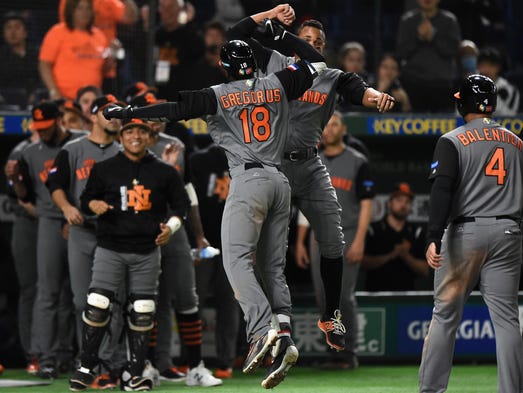Future success of World Baseball Classic lies with American players – Detroit Free Press
MIAMI – The cheers had not quieted, not some 15 minutes after the Dominican Republic captured another World Baseball Classic win, this time in crazy, come-from-behind fashion on Saturday night.
The cheers permeated the news conference room at Marlins Park, where they could be heard between each and every thought United States manager Jim Leyland had about his team’s late collapse.
In the middle of March, this was postseason baseball. There was no doubt about it.
It’s hard to pinpoint an exact moment I bought into the WBC. Driving down from Lakeland, Fla., for the weekend, I was admittedly indifferent about the three-week baseball tournament, awkwardly scheduled in the middle of spring training, without many of the game’s biggest stars.
That sentiment is shared by many baseball fans and big league players alike.
Related:
But by the time Nelson Cruz hit a game-winning, three-run home run to complete a stunning comeback and send 30,000 Dominicans into a frenzy that shook the stadium, I was all-in.
The big star of the weekend was not Cruz, or the Dominican Republic team, or any singular player or moment. It was the Dominican fans which packed Marlins Park for three drama-filled days, beginning on Thursday.
They brought their drums and airhorns and saxophones and more closely resembled soccer fans with the kind of enthusiasm you don’t even see at a Game 7 of the World Series.
But they also represented the kind of challenge the WBC has going forward.
After another sold-out crowd packed the stadium Sunday to watch an amazing game between the Dominican Republic and Colombia, the first pitch crowd between the U.S. and Canada resembled more of a Grapefruit League game.
The Dominicans came in droves because of their close proximity to Miami, and in the process showed what kind of an event the WBC can become. There is plenty of doubt as to the future of the event, but this edition has featured the best baseball in the tournament’s history. Colombia, for example, came so excruciatingly short against the two powers of the tournament, taking both the U.S. and Dominican Republic to extra innings before losing both games.
The burden of the tournament remains with the U.S. and convincing its biggest stars like Mike Trout, Bryce Harper and Noah Syndergaard to compete for their countries. This year represents a big step forward in the name-brand value of the players participating, but for it to truly resonate with American baseball fans, it must carry such players to convey the top level of competition.
It will never be the World Series, which is what youngsters around the country dream of playing in. Therein might lie the problem. Around the world, this is each country’s chance to put their stamp on America’s pastime. But in America, players are more focused on other things. With so much money on the line, in many cases, that’s understandable.
But if this weekend showed anything, it is the potential that this tournament carries if the kinks are worked out.
There will always be those who point to the injury concerns that come with having players not yet fully prepared for top competition. It’s plausible that there’s a better time for this three-week event – say, in the middle of the baseball season. And after seeing it for the first time in person, the extra inning rules of starting with runners on first and second base in the 11th inning and later should be discarded. Though it’s understandable why it’s implemented: The longer these games go on, the more likely a manager is put in a bind to tax a bullpen of arms not fully game-ready.
But as someone whose interest in the tournament was aligned with the average baseball fan – it’s cool to watch competitive baseball as an appetizer to the regular season – seeing the kind of atmosphere in Miami this weekend made me a believer that this tournament can grow even more in the future. It’s up to the U.S. to make that happen.
Contact Anthony Fenech: afenech@freepress.com. Follow him on Twitter @anthonyfenech.







































































































